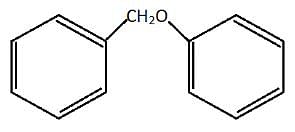Chemistry: CUET Mock Test - 5 - CUET MCQ
30 Questions MCQ Test CUET Mock Test Series - Chemistry: CUET Mock Test - 5
Which of the following is the most suitable requirement for the dehydration of ethanol to form an ether?
What is the major product formed when ethanol is dehydrated with concentrated H2SO4 at 413K?
| 1 Crore+ students have signed up on EduRev. Have you? Download the App |
The reaction between tert-Butyl chloride and sodium ethoxide gives ____
What is defined as the concentration of dissolved solute in a solvent beyond which none of it, if added to the solvent, will increase the concentration further more?
Which of the following is the least reactive functional group?
What product(s) are formed when the shown ether is heated with hydrogen iodide?

Identify the major product of Friedel-Crafts acylation of anisole with ethanoyl chloride?
4-Nitroanisole is obtained as the major product when anisole reacts with _____
Cumene hydroperoxide on hydrolysis with dilute H2SO4 gives _________
Which of the following is the least soluble in water?
Phenol is approximately how much times acidic than ethanol?
What is the correct order of boiling points of alcohols having the same number of carbon atoms?
If the boiling point of methoxymethane is 248K, predict the boiling point of ethanol.
How does the solubility of gas change in a liquid, as described?
If, at 298 K water is the solvent, and Henry’s law constant for CO2 is 1.67 kbar and the constant of argon is 40.3 kbar, which of the following statements is true?
Phenol can be obtained by ________ of sodium phenoxide.
How is carbolic acid prepared from benzene diazonium chloride?
Which of the following isomeric alcohols is the most soluble in water?
Which of the following is necessary for the bromination of phenol?
our compounds A, B, C and D having similar molecular masses were tested for their boiling points. It was found that compound C has the highest boiling point of all four. What is the compound C most likely to be?
Which of the following has the highest boiling point?
Which of the following process do not yield alcohols?
Propene when reacted with water in the presence of H2SO4 gives _________
Identify the nucleophile that attacks the carbocation in the second step of acid catalysed hydration of alkenes?
Which compound reacts with propene to form tripropyl borane?
What is the concentration of N2 in a fresh water stream in equilibrium with air at 298 K and 1 atmosphere? Given the value of KH for N2 = 0.00060 mole/kgbar.
Which carbonyl compound yields secondary alcohols when treated with LiAlH4?
Hydrolysis of the adduct formed form the reaction of ________ with methyl magnesium bromide gives 2-Methylpropan-2-ol.
|
8 docs|148 tests
|


















